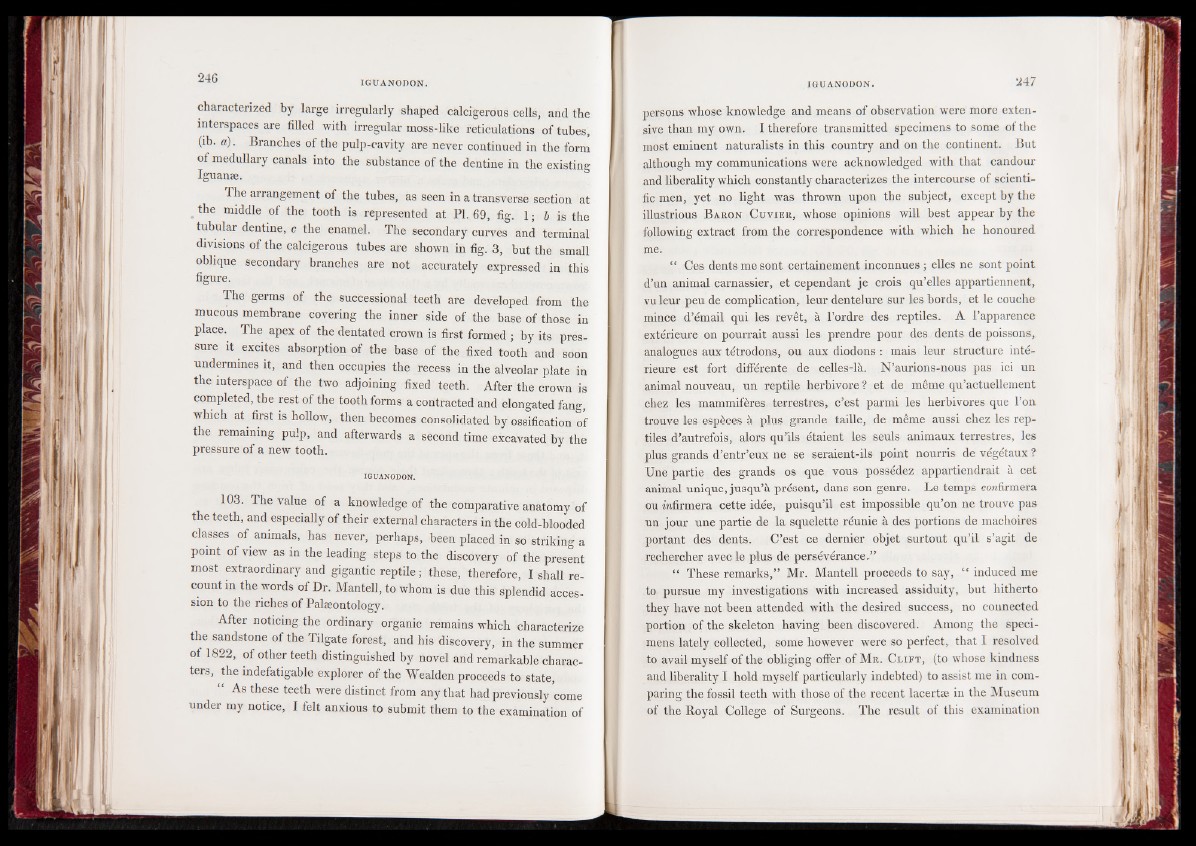
characterized by large irregularly shaped calcigerous cells, and the
interspaces are filled with irregular moss-like reticulations of tubes,
(lb. a). Branches of the pulp-cavity are never continued in the form
of medullary canals into the substance of the dentine in the existing
Iguanse.
The arrangement of the tubes, as seen in a transverse section at
the middle of the tooth is represented at PI. 69, fig. 1 • 6 is the
tubular dentine, c the enamel. The secondary curves and terminal
divisions of the calcigerous tubes are shown in fig. 3 , but the small
oblique secondary branches are not accurately figure. expressed in this
The germs of the successional teeth are developed from the
mucous membrane covering the inner side of the base of those in
place. The apex of the dentated crown is first formed ; by its pressure
it excites absorption of the base of the fixed tooth and soon
undermines it, and then occupies the recess in the alveolar plate in
the interspace of the two adjoining fixed teeth. After the crown is
completed, the rest of the tooth forms a contracted and elongated fang,
which at first is hollow, then becomes consolidated by ossification of
the remaining pulp, and afterwards a second time excavated by the
pressure of a new tooth.
IGUANODON.
103. The value of a knowledge of the comparative anatomy of
the teeth, and especially of their external characters in the cold-blooded
classes of animals, has never, perhaps, been placed in so striking a
point of view as in the leading steps to the discovery of the present
most extraordinary and gigantic reptile; these, therefore, I shall recount
in the words of Dr. Mantell, to whom is due this splendid acces-
sion to the riches of Palaeontology.
After noticing the ordinary organic remains which characterize
the sandstone of the Tilgate forest, and his discovery, in the summer
of 1822, of other teeth distinguished by novel and remarkable characters,
the indefatigable explorer of the Wealden proceeds to state,
“ As these teeth were distinct from any that had previously come
under my notice, I felt anxious to submit them to the examination of
persons whose knowledge and means of observation were more extensive
than my own. I therefore transmitted specimens to some of the
most eminent naturalists in this country and on the continent. But
although my communications were acknowledged with that candour
and liberality which constantly characterizes the intercourse of scientific
men, yet no light was thrown upon the subject, except by the
illustrious B aron C u v ie r , whose opinions will best appear by the
following extract from the correspondence with which he honoured
me.
“ Ces dents me sont certainement inconnues ; elles ne sont point
d’un animal carnassier, et cependant je crois qu’elles appartiennent,
vu leur peu de complication, leur dentelure sur les bords, et le couche
mince d’émail qui les revêt, à l’ordre des reptiles. A l’apparence
extérieure on pourrait aussi les prendre pour des dents de poissons,
analogues aux tétrodons, ou aux diodons : mais leur structure intérieure
est fort différente de celles-là. N’aurions-nous pas ici un
animal nouveau, un reptile herbivore ? et de même qu’actuellement
chez les mammifères terrestres, c’est parmi les herbivores que l’on
trouve les espèces à plus grande taille, de même aussi chez les reptiles
d’autrefois, alors qu’ils étaient les seuls animaux terrestres, les
plus grands d’entr’eux ne se seraient-ils point nourris de végétaux ?
Une partie des grands os que vous possédez appartiendrait à cet
animal unique, jusqu’à présent, dans son genre. Le temps confirmera
ou infirmera cette idée, puisqu’il est impossible qu’on ne trouve pas
un jour une partie de la squelette réunie à des portions de mâchoires
portant des dents. C’est ce dernier objet surtout qu’il s’agit de
rechercher avec le plus de persévérance.”
“ These remarks,” Mr. Mantell proceeds to say, c< induced me
to pursue my investigations with increased assiduity, but hitherto
they have not been attended with the desired success, no connected
portion of the skeleton having been discovered. Among the specimens
lately collected, some however were so perfect, that I resolved
to avail myself of the obliging offer of M r . C l i f t , (to whose kindness
and liberality I hold myself particularly indebted) to assist me in comparing
the fossil teeth with those of the recent lacertæ in the Museum
of the Royal College of Surgeons. The result of this examination